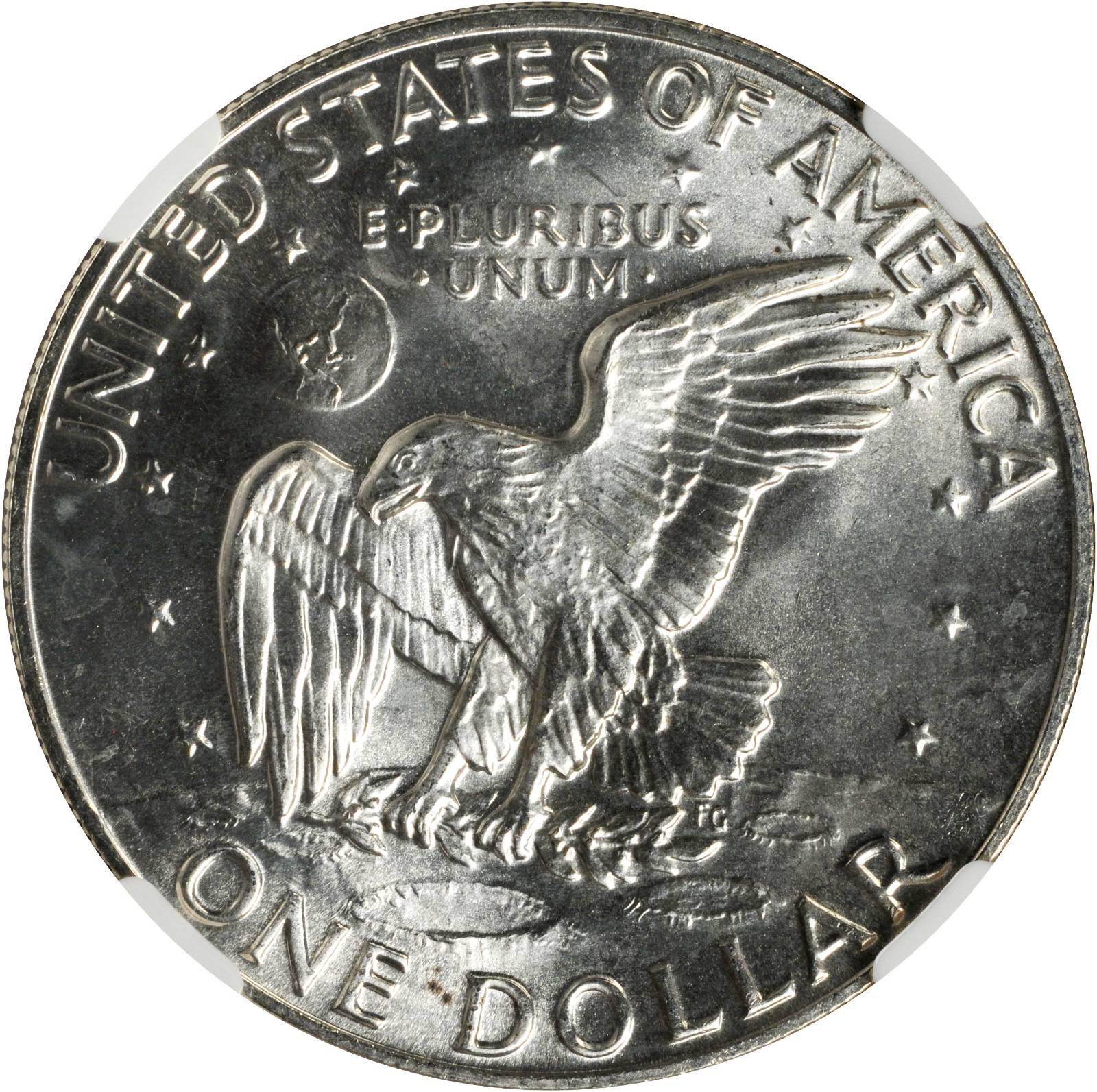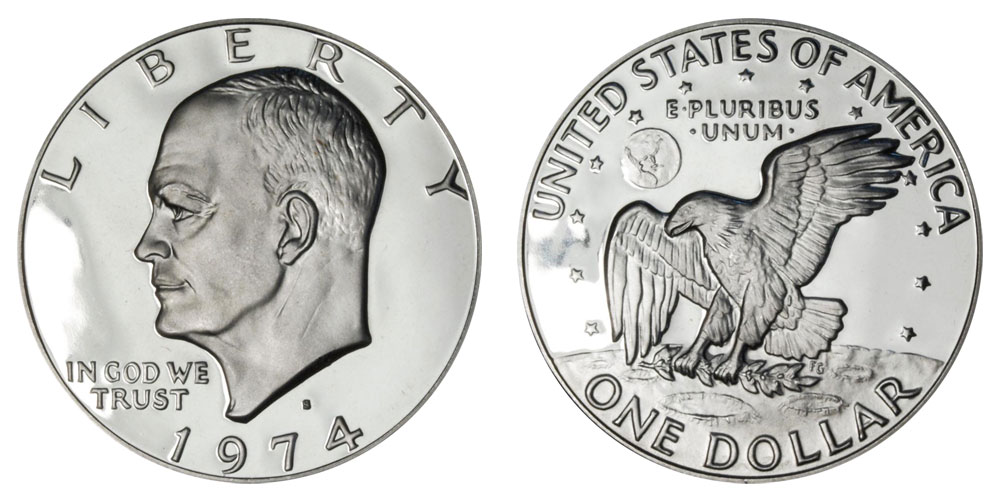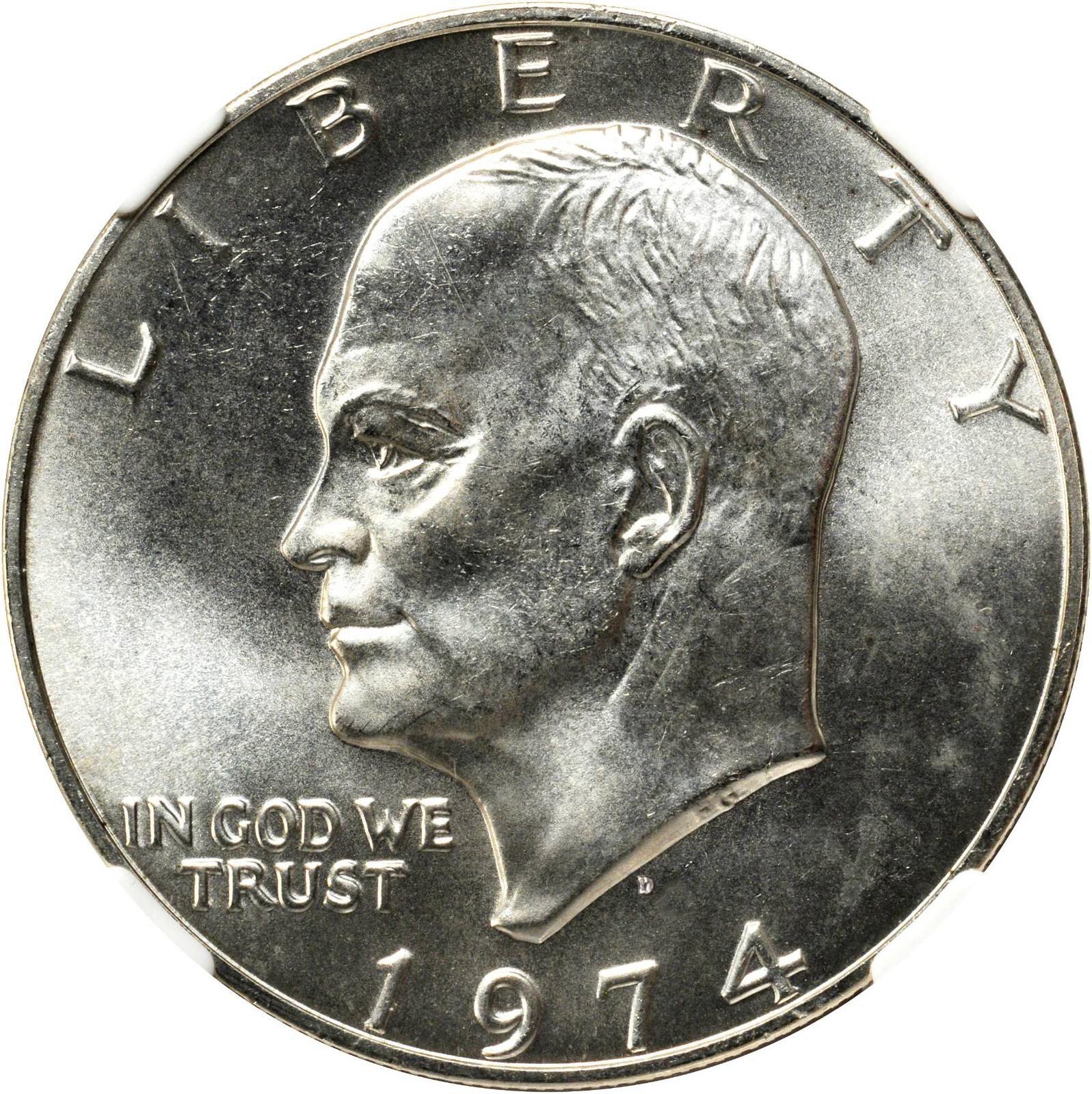1974 Silver Dollar
- 1974 Silver Dollar Proof
- 1974 Silver Dollar No Mint Mark
- 1974 Silver Dollar Worth
- 1974 Silver Dollar Price
- 1974 Silver Dollar With Eagle On Back Value


- The 1974D Silver clad Eisenhower dollars were discovered by a blackjack dealer in Las Vegas. So far, only about 30 pieces are known to exist. The normal clad pieces have a red or, when oxidized, dark gray edge. Silver clad pieces have a white edge. Silver clad piece weigh 24.59 grams, copper-nickel clad examples, 22.68 grams.
- I have some silver dollars dating 1776-1976 with the liberty bell, 1977 silver dollar with an eagle, 1986 silver dollar with the queen, 2-silver dollars with queen & eagle dated 1921, 2- with eagle (sitting not flying) 1922, 1928, 1923 silver dollars, 1979 silver dollar, and 1990 and 1884 silver dollar, 1905 silver dollar.
1974 Eisenhower silver dollars are widely collected by numismatists who assemble complete date-and-mintmark sets of the dollar coin, though there are many bullion investors who have also purchased 40 percent silver Eisenhower dollars to include in their portfolios.
Like Ike? Plenty of coin collectors do! A growing number of numismatists are building sets of Eisenhower dollars.
Read below for a full list of Eisenhower dollar prices.
The Eisenhower dollar was struck from 1971 through 1978 and was intended for regular commerce. Ultimately it failed to see the light of day as a circulating coin beyond the casinos of Las Vegas.
Few people knew back in the 1970s that the Eisenhower dollar would be the last circulating large-size dollar coin in the United States.
Today, it's become one of the top modern collectible coins, and for good reason. Ike dollars constitute a relatively short series with many unusual varieties to collect.
What Are Eisenhower Dollars Worth?
Eisenhower dollars appeal to collectors on a variety of budgets. Many pieces challenge even financially well-heeled collectors. Prices for some key date Ike dollars reach into the thousands of dollars.
Nonetheless, the majority of Eisenhower dollars are much more affordable to obtain. What follows is an Eisenhower dollar price guide. The values reflect examples in MS-63 (uncirculated) and Proof-65 grades.
Eisenhower Dollar Price Chart
| Date | Composition & Finish | Price |
|---|---|---|
| 1971 | Copper-Nickel Clad Uncirculated | $4 |
| 1971-D | Copper-Nickel Clad Uncirculated | $3.50 |
| 1971-S | 40% Silver Clad Uncirculated | $10 |
| 1971-S | 40% Silver Clad Proof | $11 |
| 1972 | Copper-Nickel Clad Uncirculated | $3.50 |
| 1972-D | Copper-Nickel Clad Uncirculated | $3.50 |
| 1972-S | 40% Silver Clad Uncirculated | $10 |
| 1972-S | 40% Silver Clad Proof | $11 |
| 1973 | Copper-Nickel Clad Uncirculated | $10 |
| 1973-D | Copper-Nickel Clad Uncirculated | $10 |
| 1973-S | Copper-Nickel Clad Proof | $11 |
| 1973-S | 40% Silver Clad Uncirculated | $11 |
| 1973-S | 40% Silver Clad Proof | $30 |
| 1974 | Copper-Nickel Clad Uncirculated | $4.50 |
| 1974-D | Copper-Nickel Clad Uncirculated | $4.50 |
| 1974-S | Copper-Nickel Clad Proof | $5 |
| 1974-S | 40% Silver Clad Uncirculated | $11 |
| 1974-S | 40% Silver Clad Proof | $13 |
| 1776–1976 | Copper-Nickel Clad Variety I (Thick Reverse Letting) Uncirculated | $6 |
| 1776–1976 | Copper-Nickel Clad Variety II (Serifed Lettering) Uncirculated | $3.50 |
| 1776–1976-D | Copper-Nickel Clad Variety I Uncirculated | $3.50 |
| 1776–1976-D | Copper-Nickel Clad Variety II Uncirculated | $3.50 |
| 1776–1976-S | Copper-Nickel Clad Variety I Proof | $8 |
| 1776–1976-S | Copper-Nickel Clad Variety II Proof | $6 |
| 1776–1976-S | Silver Clad Variety I Uncirculated | $14 |
| 1776–1976-S | Silver Clad Variety I Proof | $17 |
| 1977 | Copper-Nickel Clad Uncirculated | $3.50 |
| 1977-D | Copper-Nickel Clad Uncirculated | $3.50 |
| 1977-S | Copper-Nickel Clad Proof | $4 |
| 1978 | Copper-Nickel Clad Uncirculated | $3.75 |
| 1978-D | Copper-Nickel Clad Uncirculated | $3.50 |
| 1978-S | Copper-Nickel Clad Proof | $4 |
All the values listed above represent typical specimens. These have regular surface quality for their respective grades and conditions.
Better pieces command significantly higher premiums than the prices listed above. This is due to the difficulty of locating Eisenhower dollars (mainly clad business strikes) with few marks.
How the Eisenhower Dollar Was Created
United States Mint Chief Engraver Frank Gasparro created the coin's design. The first Eisenhower dollars were struck in 1971.

Cupro-nickel clad versions were produced at the Philadelphia and Denver Mint for circulation. Meanwhile, 40% silver examples were made in San Francisco as proofs for collectors.
Copper-nickel S-mint proofs didn't come around until 1973. This was the first year that regular uncirculated sets and proof sets included the Eisenhower dollar.
In 1975, the U.S. Mint began producing special commemorative circulating Eisenhower dollars honoring the 200th anniversary of the signing of the Declaration of Independence.
These Bicentennial dollars showcase a dual-dating feature declaring 1776–1976 on the obverse. The reverse design by Dennis Williams features the Liberty Bell superimposed on the Moon.
The standard Eisenhower dollar reverse and obverse dating resumed in 1977. Yet the end was in sight for the coin in 1978.
The public deemed the Eisenhower dollar too large. Americans were unwilling to carry large numbers of the heavy dollar coins during a period of runaway inflation.
40% Silver Eisenhower Dollar
The large dollar coin had failed to circulate well and was thus retired before 1979. This was when the Susan B. Anthony dollar, also designed by Gasparro, entered circulation.
However, the Susan B. Anthony dollar never caught on with the public, either. It was retired shortly after that in 1981. It returned for a one-year stint a general later in 1999 before being put out to numismatic pasture for good.
Collecting Eisenhower Dollars
The vast majority of hobbyists who collect Eisenhower dollars aim to complete a 32-coin set. It consists of all the regular-issue business-strike and proof coins. This includes the 40% silver Ikes dated 1971-S, 1972-S, 1973-S, 1974-S, and 1976-S.
Tricky Ikes: Only a small percentage of the total Eisenhower dollar mintage is 40% silver. Image source: Reddit user rddt1983
1974 Silver Dollar Proof
Such a set can be completed with coins in typical uncirculated and proof grades for less than $500. That includes the 40% silver key dates mentioned above.
Collectors with deeper pockets will add a much more expensive dimension to their Ike dollar objectives. They often pursue each of the regular-issue clad coins in Gem grades. They target proofs that grade Proof-67 or higher. Many will also seek the abundance of scarce varieties known for this series.
Surprisingly, clad business strikes in grades of MS-65 to MS-66 or better are among the most valuable Eisenhower dollars. There are few such Ikes that grade MS-68 or better.

The United States Mint took little care in handling or transporting these large, heavy circulating dollar coins. Understanding this, it becomes clearer why clad Ikes in Gem condition are so tough to locate. Most of the rarest Gem examples trade for more than $1,000 today.
Eisenhower Proofs
Top-end proofs are not nearly as rare as their high-grade clad business-strike counterparts. They are tough to find with full cameo frosting, however. The 40% silver Ikes are among the easiest examples to find in grades of Proof-69 or Proof-70.
Meanwhile, deep cameo contrast is most common on the 1977-S and 1978-S Eisenhower dollars. This originated from a period when deep cameo frosting was becoming more the norm rather than the exception for U.S. proof coinage.
1972 Eisenhower Variety
Image: USA CoinBook
The Eisenhower dollar boasts a wide array of varieties. Those who collect design varieties have plenty to love.
The most popular varieties are found among 1972 Ikes. It showcases at least three different versions of planet Earth on the reverse design.
Type I is a relatively low-relief variety showing three islands to the right of Florida.
Type II, the scarcest of these three varieties, shows no islands below Florida. (Water lines are in their place instead.)
Type III shows three islands below and to the left of Florida.
Clearly, there are some geography issues at hand with these varieties. They keep collectors busy!
1974 Silver Dollar No Mint Mark
Several other exciting oddities are out there. This includes various doubled dies and the rare 1974-D and 1977-D 40% silver transitional wrong-metal strikes.
There are numerous avenues in the Eisenhower dollar series that one can take. So many collectors have devoted their entire numismatic careers just to the Eisenhower dollar.
These modern clad coins offer a multitude of rewarding opportunities for collecting, research, and discovery—enough to satisfy even the most passionate of dedicated collectors for a lifetime!
Joshua McMorrow-Hernandez is a journalist, editor, and blogger who has won multiple awards from the Numismatic Literary Guild. He has also authored numerous books, including works profiling the history of the United States Mint and United States coinage.
1974 Silver Dollar Worth
More from the author:
David C. writes: I have a 1974D Eisenhower dollar that appears to be silver rather than the copper clad mix. Upon further research I found out that in 1974 and 1977 there were Eisenhower dollars of Denver mintage that were made in silver clad by error. I have taken this coin to numerous dealers and they all agree that it is indeed silver clad and not copper clad, but none of these dealers having ever seen one of these mistakes they can’t be certain that this is one of the error coins even though it is silver. Who or where can I find out if this paticular coin is one of the errors?
The 1974D Silver clad Eisenhower dollars were discovered by a blackjack dealer in Las Vegas. So far, only about 30 pieces are known to exist. The normal clad pieces have a red or, when oxidized, dark gray edge. Silver clad pieces have a white edge. Silver clad piece weigh 24.59 grams, copper-nickel clad examples, 22.68 grams. A ring test (see a numismatist for this) yields a different pitch for each type.
1974 Silver Dollar Price
If you believe you have a silver clad 1974D dollar, you will want to have it certified or authenticated. You can contact ANA, PCGS or NGC for reliable authentication. See their links on the CoinSite Links page.